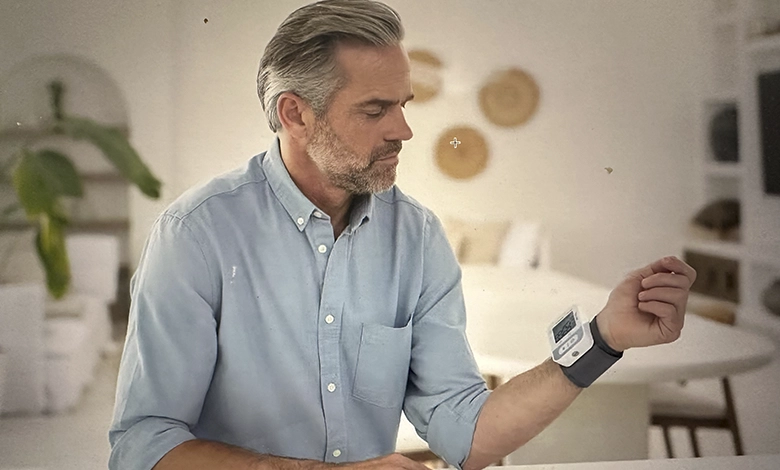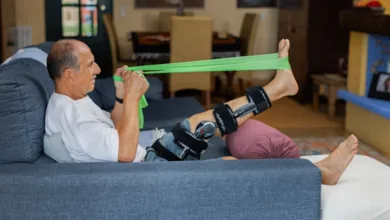How to Get Accurate BP Readings with a Wrist Blood Pressure Monitor

Why accurate BP readings matter for your health
You bought the wrist blood pressure monitor. You charged it, read (most of) the instructions, and took your first reading. Then you took another one five minutes later and got a completely different number. Frustrating, right?
Monitoring your blood pressure at home has never been more convenient, thanks to modern wrist blood pressure monitors. These compact devices offer a practical alternative to traditional upper-arm cuffs, making it easier to track your cardiovascular health regularly. However, getting accurate BP readings requires more than just strapping on the device and pressing a button. The key lies in understanding how to use your monitor correctly and consistently. Continue reading to explore tips to help you get accurate wrist BP monitor readings.
5 essential tips for using your wrist blood pressure monitor
Master these BP monitor tips, and you’ll build a tracking system that actually helps you and your doctor make informed decisions about your cardiovascular health.
1. Position your wrist at heart level
The most critical factor for accurate wrist blood pressure readings involves proper positioning. Place your wrist at the same level as your heart during each measurement. Sit in a comfortable chair with your feet flat on the floor, then rest your arm on a table or armrest so your wrist aligns with your chest.
If your wrist sits too high or too low, you’ll get readings that don’t reflect your actual blood pressure. This positioning rule applies every single time you take a measurement, as even small deviations can throw off your results by several points.
2. Choose the correct cuff size
Your wrist blood pressure monitor cuff must fit properly around your wrist to deliver reliable readings. Most wrist monitors accommodate wrist circumferences between 5.3 and 8.5 inches, but don’t guess, measure your wrist before purchasing a device.
Wrap the cuff snugly around your wrist, leaving just enough room to slip one finger underneath. It should feel secure but not uncomfortably tight. Think “firm handshake,” not “tourniquet.”
A cuff that’s too loose will give you artificially high readings because it can’t properly detect your pulse pressure. One that’s too tight restricts blood flow and skews results in the opposite direction. Wrist BP monitors are reliable for daily use when you match the cuff size to your anatomy correctly.
3. Create a calm environment
Your blood pressure responds to everything happening around you and inside you. External distractions and internal stress directly impact your readings, which is why measurement conditions matter as much as technique.
Find a quiet space where you won’t be interrupted. Avoid taking measurements immediately after physical activity, consuming caffeine, smoking, or dealing with stressful situations, all of these temporarily elevate your numbers. Sit quietly for at least five minutes before taking your reading and resist the urge to talk or check your phone during the measurement process.
Your body needs time to settle into a resting state for the most accurate BP readings. Regular health screenings are impactful when conducted under consistent, calm conditions, which means creating the same peaceful environment each time you measure.
4. Calibrate your monitor regularly
Like any measuring device, wrist blood pressure monitors can drift from their original accuracy over time. Sensors age, batteries weaken, and internal components shift — it’s normal wear and tear, but it affects reliability.
Compare your home readings with those taken during doctor visits. If you notice consistent differences of more than 5-10 points, contact the manufacturer for guidance. Many healthcare providers recommend bringing your monitor to appointments occasionally for side-by-side comparison testing.
Some monitors also feature automatic calibration reminders or self-checking functions that help maintain accuracy. Pay attention to these alerts; they’re not optional maintenance suggestions.
5. Follow the manufacturer’s guidelines
Every wrist blood pressure monitor comes with specific instructions that reflect its unique design and technology. These aren’t generic suggestions copied from a template; they’re tailored to how your particular device measures and calculates blood pressure.
Read through the entire manual before your first use, paying special attention to timing recommendations, measurement frequency, and maintenance requirements. Some devices work best when you take multiple readings in succession and average the results. Others recommend single measurements with a few minutes of rest between attempts.
Following these BP monitor tips consistently will give you the most reliable data for tracking your cardiovascular health over time. When everyone follows the same protocol—you, your doctor, and your device—the numbers tell a story you can actually trust.
Common mistakes that affect monitor accuracy
Even with the best intentions, certain habits can sabotage your readings. Watch out for these sneaky accuracy killers:
Measuring at inconsistent times: Your blood pressure changes throughout the day based on meals, medications, activity, and stress levels. Take your readings at the same time each day for the most comparable results. Morning measurements before breakfast and evening readings before dinner work well for most people, but what matters most is consistency.
Talking during measurement: Conversation raises your blood pressure temporarily, even casual chat. Stay silent and still from the moment you press start until the device displays your results.
Wearing the cuff over clothing: Always place your wrist blood pressure monitor directly against bare skin. Fabric creates a barrier that interferes with the sensors, and even thin sleeves can affect accuracy.
Moving during measurement: Even small movements — shifting your weight, adjusting your arm, flexing your fingers — can disrupt the reading process. Sit still and breathe normally until the measurement completes.
Taking one reading and calling it done: Blood pressure fluctuates minute to minute. Many experts recommend taking two or three readings at each session (with a minute of rest between) and recording the average. Your device manual will specify what works best for your model.
Ignoring multiple high readings: If you consistently get elevated numbers at home, don’t dismiss them as “white coat syndrome in reverse.” Share your readings with your healthcare provider for evaluation. Home monitoring exists to catch problems early, not to reassure you everything’s fine when it isn’t.
Best times to check your blood pressure at home
Timing matters for accurate BP readings. Your blood pressure isn’t a fixed number, it’s a constantly shifting measurement that responds to everything from your stress level to whether you just climbed stairs.
Establish a consistent schedule that makes sense for your lifestyle and gives you meaningful data:
Morning measurements: Check your blood pressure first thing after waking, before taking any medications and before eating breakfast. Use the bathroom first (a full bladder raises blood pressure slightly), then settle into your quiet spot for measurement. This gives you a baseline reading that reflects your cardiovascular state during rest, before the day’s activities affect your numbers.
Evening measurements: Take a second reading in the early evening, ideally before dinner and before taking any evening medications. This helps you track how your blood pressure changes throughout the day and whether your treatment plan is working consistently.
Pre-appointment readings: In the week before a doctor visit, take daily readings at consistent times. Bring this record to your appointment — it gives your healthcare provider much more information than the single reading taken in the exam room. Many people experience “white coat syndrome” (elevated readings in medical settings), so home data helps paint a more accurate picture of your typical blood pressure patterns.
Most experts recommend checking twice daily if you’re managing high blood pressure but follow your doctor’s specific guidance for your situation. More isn’t always better — obsessive monitoring can increase anxiety, which ironically raises your blood pressure.

Building confidence in your home monitoring routine
The goal isn’t perfection, it’s consistency. You don’t need to stress about whether you pressed the button at exactly 7:00 AM or 7:03 AM. What matters is creating a routine you can stick with, measuring under similar conditions each time, and recording your results honestly.
Remember that home monitoring complements, but doesn’t replace, regular medical care. Use your readings to have informed conversations with your healthcare team and make confident decisions about your health management strategy. When you spot trends — whether positive or concerning — you’re equipped to act early rather than waiting for your next annual physical.
Your wrist blood pressure monitor is a tool, not a crystal ball. Use it wisely, trust the process, and give yourself credit for taking an active role in your cardiovascular health.
Taking accurate blood pressure readings at home empowers you to stay on top of your health between medical appointments. With these five BP monitor tips, you’ll get the most reliable results from your wrist blood pressure monitor and build a valuable record of your cardiovascular wellness. You’ve got this.
Want more practical health and wellness tips for living well after 50? Join our fyi50+ community for inspiring stories, expert advice, and reminders that your best years are still ahead.





